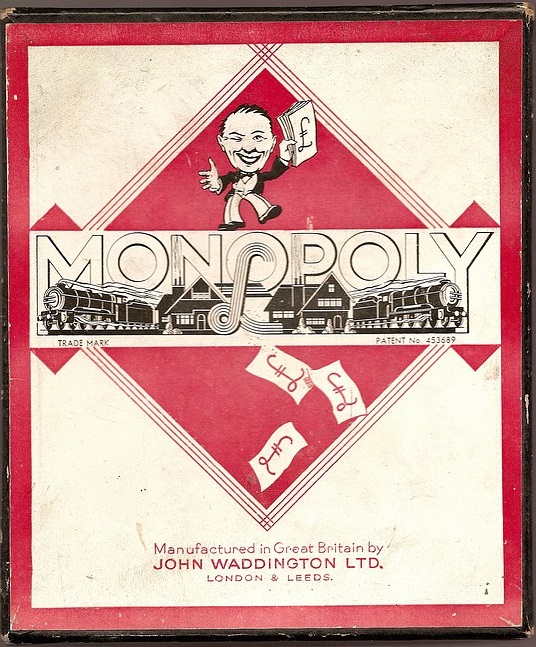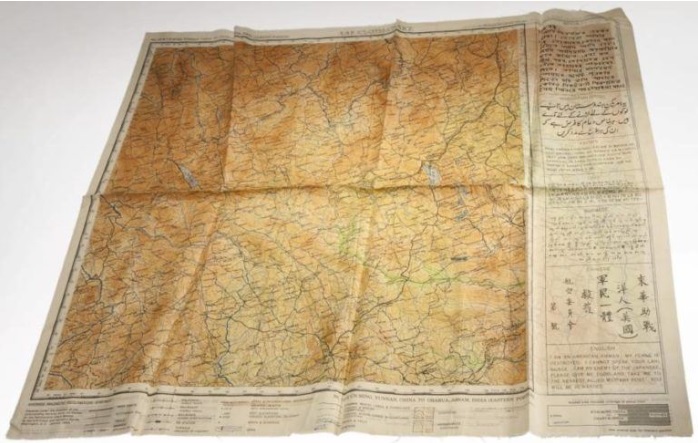Elizabeth Harrison
Starting in 1941, an increasing number of British Airmen found themselves as involuntary guests of the Third Reich as POWs, and the Military Intelligence Services were looking for ways and means to facilitate their escape.
Now, obviously, one of the most helpful aids to that end is a useful and accurate map, one showing not only where key points were, but also showing the areas of ‘safe houses’ where a POW on-the-run could go for food and shelter. Paper maps had some real drawbacks – they make a lot of noise when you open and fold them, they wear out rapidly and, if they get wet, they turn into mush.

John Waddington was a theatrical printer in Leeds in 1896. In 1921 he started making playing cards. In the early 1930s, Waddingtons was sent a new board game from the USA developed by the Parker brothers called Monopoly. The board game had been created by an out of work heating engineer called Charles B Darrow, and centred on buying and selling property in the streets around Atlantic City, New Jersey. Waddingtons was asked to test the game, they were very impressed, contacted the Parker brothers, and received the rights to sell the game worldwide and adapt it to suit a British market. After a frantic dash to London and a taxi around the main routes, all street and road names were changed to London addresses.
In WW2 Waddingtons adapted their games to suit the war effort. Working alongside SIS, SOE, MI9, MI I9 and other covert agencies, maps, money and steel files were concealed in Monopoly games and playing cards and sent to POW camps in Germany and Italy to assist the escape of prisoners. As it happened, ‘games and pastimes’ were a category of item qualified for insertion into CARE packages, dispatched by the International Red Cross to prisoners-of-war.

The idea was also to print maps on silk. It’s durable, can be scrunched-up into tiny wads, can be unfolded as many times as needed, and makes no noise whatsoever. At that time, there was only one manufacturer in Great Britain that had perfected the technology of printing on silk and that was John Waddington Ltd. When approached by the Government, the firm was only too happy to do its bit for the war effort. Today, silk maps are still printed for use by Special Forces and also used in escape kits for soldiers and aircrew
Under the strictest secrecy, in a securely guarded and inaccessible old workshop on the grounds of Waddingtons, a group of sworn-to-secrecy employees began mass-producing escape maps, keyed to each region of Germany and Italy where Allied POW camps were a regional system. When processed, these maps could be folded into such a small size that they would actually fit inside a Monopoly playing piece. As the war continued the clever workmen at Waddingtons also managed to add a playing token containing a small magnetic compass; a two-part metal file that could easily be screwed together; and useful amounts of genuine high-denomination German, Italian, and French currency, hidden within the piles of Monopoly money!
British and American air crews were advised, before taking off on their first mission, how to identify a ‘rigged’ Monopoly set by means of a tiny red dot, one cleverly rigged to look like an ordinary printing glitch, located in the corner of the ‘Free Parking’ square.
Of the estimated 35,000 Allied POWS who successfully escaped, an estimated one-third were aided in their flight by the rigged Monopoly sets. Everyone who did so was sworn to the Official Secrets Act indefinitely, since the British Government might want to use this highly successful ruse in another future war. The story wasn’t declassified until 2007, when the surviving craftsmen from Waddingtons, as well as the firm itself, were finally honoured in a public ceremony.
It’s always nice when you can play that ‘Get out of Jail Free’ card!
